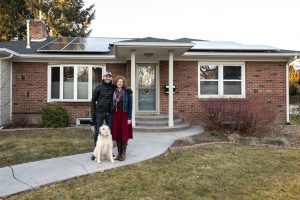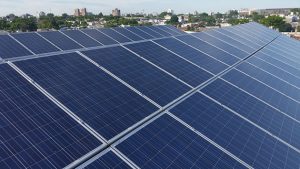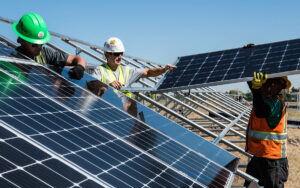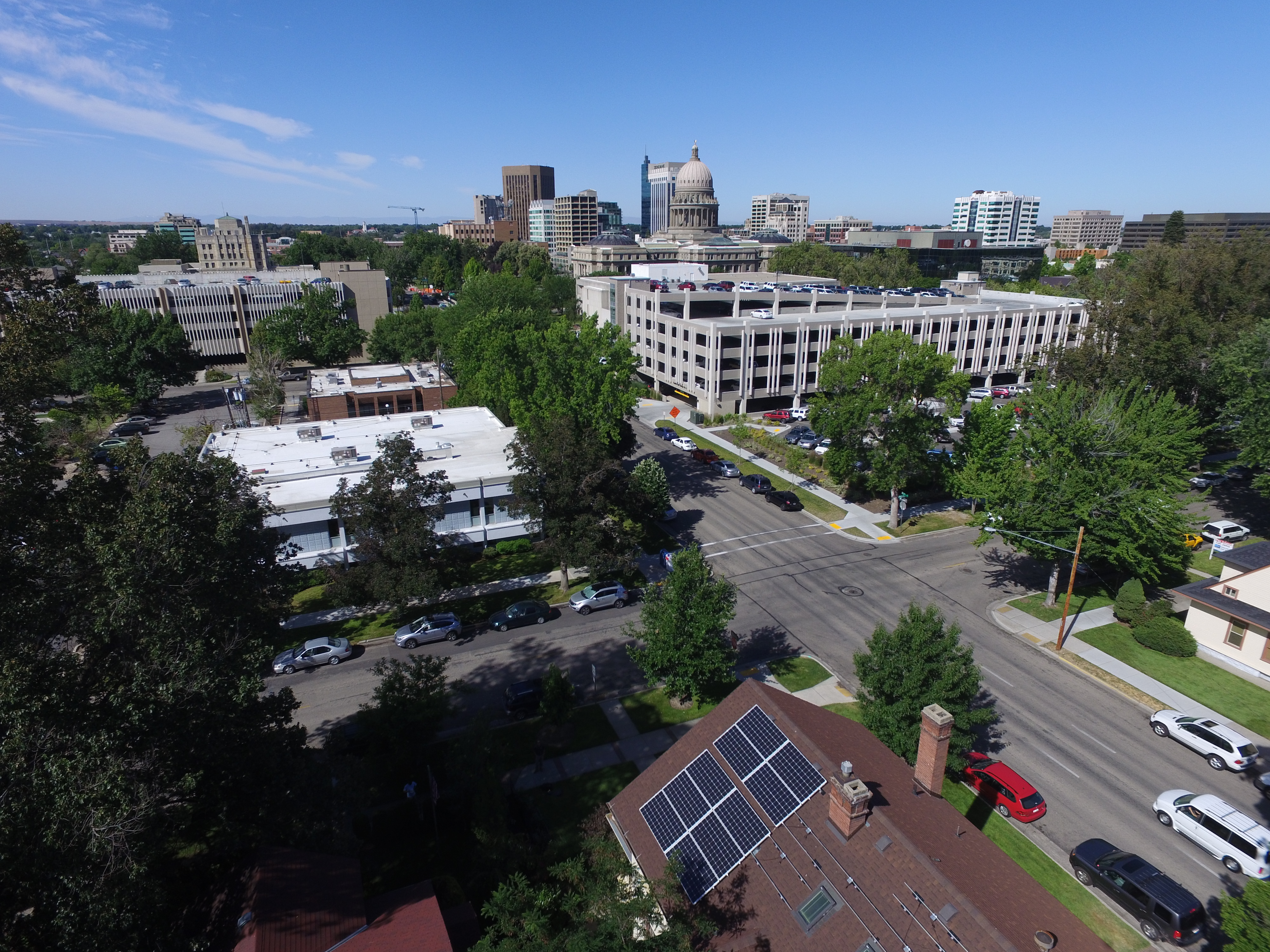Editor’s Note: This blog was coauthored by Adrian Gallo, ICL Climate Program Manager; John Robison, ICL Public Lands & Wildlife Director; and Brad Heusinkveld, ICL Energy Policy Associate.
When the Four Corners fire blew up on West Mountain near Cascade, Idahoans came together to fight the flames, help their neighbors, and look after each other. Other communities across the country have also experienced uncharacteristic wildfires or the smoke from wildfires. Hotter temperatures and longer fire seasons are driving more extreme fire behavior across the West. Communities are not just working to reduce hazardous fuels around homes, but are also looking at the source of these extreme temperatures. The primary way to counter these extreme events is to phase out fossil fuels that are warming our planet.
Solar energy is perhaps the most immediate tool in the tool box to protect our quality of life from continued impacts of climate change. Over a decade ago, the Bureau of Land Management (BLM) developed a plan for the six southwestern states to help guide the siting of solar facilities on public lands so that other values were considered from the start. The BLM’s 2012 Western Solar Plan directed solar projects toward areas with 300+ days of sun each year where it made the most sense for development while protecting key habitats and sensitive areas. This proactive planning process is now expanding to include five more states in the West, including Idaho. Before we walk you through BLM’s plan, Let’s first get a bit more context about solar energy.
Solar works
Solar power is a cost-efficient, practical way to power our homes while protecting the planet. While the clouds might cover one area of the state, there are now enough solar projects and transmission lines across the West for solar to be an affordable and reliable energy source.
Solar farms take up much less space than a comparable wind farm and don’t pose the same types of risks to birds and bats or impacts to the viewshed. Unlike wind power, however, solar power is not often compatible with agriculture practices and livestock grazing. A decarbonizing grid will rely on both wind and solar power. Solar is considered an exclusive use on the landscape, as these facilities do not provide habitat for wildlife—so solar projects need to be sited carefully.

Why not just add solar to our rooftops?
Backing up a bit, do we really need solar projects on public lands? What if we just added rooftop solar on all the warehouses, houses, and parking lots, wouldn’t that be enough? This was the most consistent question I got when doing climate and energy presentations around the state. It’s a good question. The National Renewable Energy Laboratory modeled out the most optimistic scenario of urban solar development, including solar on warehouses and all rooftops that were big enough to fit a panel—regardless if that rooftop could handle the weight. If we relied on the most optimistic urban solar build out scenario, we could satisfy almost 40% of our electricity demand today, but only 13% of our electricity demand in 2050. I wish we could solve our energy demand by adding solar panels to all of our urban environments, but it’s not nearly enough. We need solar so we can stop burning fossil fuels. We need it on rooftops and warehouses, on dairies to create shade for cows, and yes—even on public lands.

How big is big, and how much does it cost?
Painting with a broad brush, most residential rooftop solar systems in Idaho have the capacity to generate between 4-8 kilowatts (kW). It was rather common for rooftop solar owners having a near-zero electricity bill most of the year because of their personal generating capacity, but this recently changed. Distributed solar for farmers who irrigate, and solar systems on top of commercial buildings, are around ~100 kW. Utility-scale, or at least large enough that the power sold to the grid is for public use, occurs at the 5,000 kW (or 5 Megawatt, MW) scale.
As with most things, costs decrease as you increase in scale. Small utility scale projects (5-20MW) installation costs are about $1.25 per watt generated. Medium sized projects (20-100MW) costs between $1.20 – $1.02 per watt generated, and large projects (100-400MW) only cost $0.82 per watt generated. Because solar energy has a high initial capital investment, but relatively low maintenance, this installation/construction phase is where most of the costs occur.
What do utilities think of solar energy? If you’re willing to dig through a couple hundred page document, the 2023 Integrated Resource Plan from Idaho Power has a very helpful Table 8.4 that lists the levelized cost of energy (nerd speak for comparing infrastructure needed for a gas plant vs the infrastructure needed for a solar facility) (all numbers in dollars per Megawatt-hours).
$236 Biomass
$214 Peaking gas plant, single cycle turbine
$139 Small modular nuclear reactor
$111 Medium duration (8 hours) storage lithium-ion batteries
$89 Baseload gas plant, combined cycle turbine
$53 Wind from Idaho
$35 Wind from Wyoming
$31 Utility Scale Solar
We have said this once but we’ll say it again: the renewable energy transition is happening today (we need it to accelerate!), and it’s cheaper than ever to produce energy from solar and wind compared to burning fossil fuels! This requires us building new stuff, like transmission lines and wind and solar farms that do not currently exist. We don’t have enough space to build in urban areas, so we need to look elsewhere to produce energy. This is a trade-off: if we continue burning fossil fuels then all the wilderness areas and wildlife we love—not to mention the very communities we live in—are in peril. We believe it’s better to plan ahead where these new energy projects should go so they’re done in a sensible and responsible way. At the same time, the values that we hold dear (wildlife, water quality, recreation) can be protected from development. That’s exactly what the BLM is trying to do.

What’s in BLM’s Western Solar Plan?
You can watch or read through BLM’s updated Western Solar Plan, currently listed as the Draft Programmatic Environmental Impact Statement for utility-scale solar energy development (PEIS). You can also see their landing page for additional documentation. In this 540+ page draft, it’s obvious that the BLM has spent a considerable amount of time, outreach, and thought to develop. It’s a very sensible document and the effort shows.
The good news is that we don’t have to worry about all of southern Idaho being converted to black grids of solar panels. The amount of utility-scale solar panels that we would likely need is just shy of 90,000 acres (or 0.7% of BLM-administered lands in Idaho, and FYI, American Falls Reservoir is 55,000 acres and the BLM’s new Bennett Hills Backcountry Conservation Area is 120,000 acres). If the BLM selects its preferred alternative, that will give local communities a say in where they want and don’t want these facilities.
There are five Alternatives that the BLM is considering from least restrictive (Alternative 1) to most restrictive (Alternative 5). All five Alternatives require the adherence to 21 resource-based exclusions. These are development exclusion zones that include considerations for threatened and endangered species, Sage-grouse habitat, recreation areas, big game corridors, visual resources, national monuments, scenic rivers, and Tribal interest areas among many others. Those exclusion criteria are the bare-bone criteria; each solar development will still require project-specific NEPA analysis.
While Alternative 1 only considers resourced-based exclusions, Alternative 2 limits development to areas with less than 10% slope; a rather practical limitation to prevent soil erosion losses during construction. BLM’s preferred plan, Alternative 3, includes everything from Alternative 2 and adds in proximity to transmission lines (within 10 miles of current or planned 100kV capacity lines). The distance to transmission lines is one of the most important limitations for any energy development; it’s probably the first variable considered because the economics and technical feasibility require it. Alternative 4 uses everything from Alternative 2, and requires using lands that have been previously disturbed. The final and most restrictive Alternative 5 uses everything from Alternative 4, and adds in 10-mile proximity to transmission lines.
On its face, one might expect that we should want BLM to use the most restrictive Alternative 5: only putting solar on lands that adhere to the stringent 21-exclusion criteria, with less than 10% slope, that have been previously disturbed, and are within 10-miles from transmission lines. In the abstract we agree, but there are unintended consequences with the most restrictive option. When you narrow the scope too much, you also lose out on flexibility. There is about half of the area available for solar development in Idaho when comparing Alternative 5 (most restrictive) and 3 (BLM’s preferred alternative). The more narrow subset of land area, the more you run into more potential roadblocks that could be debilitating for our renewable energy transition.
It’s possible BLM could find sensitive areas that were previously unidentified, cultural sites that were missed, or similar issues on the most limited set of land.
In addition, if the BLM were to force all the solar development to occur on a subset of the most limited subset of lands, the people nearby will have fewer options to change outcomes. Scenario 5 has its appealing qualities, but we recognize that the speed of decarbonization is paramount, and at the same time we need to allow flexibility for communities who want a greater say in siting these projects appropriately. Unfortunately, Alternative 4 is a non-starter because of the physical limitations of needing to be near transmission lines for renewable energy development to be feasible.
So we’re back at Alternative 3, BLM’s preferred plan. It accounts for the 21-resource based exclusions, requires slopes to be less than 10% to prevent soil erosion, and has the transmission line proximity requirement that is usually the first thing energy developers consider. From what we’ve read thus far, this seems like the most logical option. This does appear to be a reasonable trade-off in protecting the public lands we recreate on, securing sensitive wildlife habitat, and protecting cultural values, while prioritizing zones that can see rapid renewable energy deployment. And while Alternative 3 checks a lot of boxes, we’re not ready to give a green light just yet…

How to improve BLM’s Western Solar Plan
There is room for improvement in this plan. First, the BLM needs to use the most recent information on winter range habitat and migration corridors for wildlife. The Idaho Department of Fish and Game has been collecting some of this information but more work is needed to make sure the exclusion areas are up to date.
Second, the BLM needs to hear from Idahoans about special places that might be overlooked such as important bird habitat, springs for wildlife and livestock, recreational trails, cultural and historic sites, and viewsheds.
Finally, as a reminder, there are currently zero solar and zero utility-scale wind facilities on BLM-administered lands in Idaho. That will change soon. This is an opportunity to make your voice heard—so stay tuned as we expand our thinking on this plan, and voice your thoughts today via email. Comments are due on April 18th, and we encourage you to participate.
Stay updated on Idaho’s changing climate—and the work being done to combat climate change—by signing up for our ICL Climate Campaign email updates!
